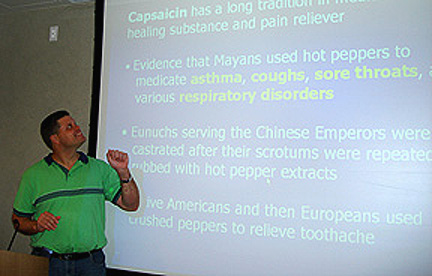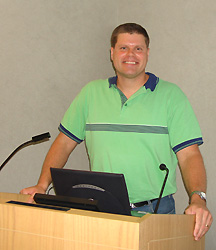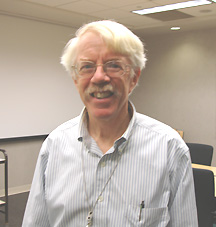
| T H E N I H C A T A L Y S T | S E P T E M B E R – O C T O B E R 2006 |
|
|
|
|
 |
 |
 |
|
Larry
Pearce
|
Peter
Blumberg
|
Peter Blumberg knows English, German, and French, but the language that best complements his native English is sign language.
For the past six or so years, Blumberg, chief of the Section on Molecular Mechanisms of Tumor Promotion, NCI, has routinely recruited postbac students from Gallaudet, a local college with a national reputation that draws deaf and hard-of-hearing students from throughout the country. His lab typically is home to one or two postbacs from Gallaudet, most of whom go on to careers in biomedical research. A current Gallaudet graduate in the Blumberg lab, Vladimir Pavlyukovets, is completing a joint NCI-Johns Hopkins master’s program in biotechnology with a concentration in molecular targets and drug discovery.
Six years ago, Larry Pearce, a Gallaudet biology major, started as a postbac in the Blumberg lab and stayed on, becoming a biologist in 2003 and, according to Blumberg, he is "the technician handling the lab’s capsaicin work and has co-authored more than 20 publications."
On an afternoon in July, Pearce conveyed the saga of capsaicin in PowerPoint and sign to 22 high school juniors and seniors from around the country who were enrolled in the Gallaudet Science Star program. A four-week summer residential program for deaf and hard-of-hearing students who intend to go to college and are interested in a career in the sciences, the program is foundation funded and designed to improve the students’ academic and laboratory skills and expose them to research facilities and scientists working in the federal and private sectors in the Washington area.
Pearce’s lively presentation traced the 10,000-year known history of capsaicin and its uses throughout the ages by Mayans, Chinese emperors, Native Americans, and Europeans–to its current standing as a heavily researched potential therapeutic in an array of medical conditions. The talk generated spirited questions from the students–some about the science presented ("How does capsaicin work?" "What part of the structure of capsaicin is responsible for the ‘burn’"?) and some about the life of the presenter ("How do you communicate with colleagues, especially those from countries where English is not the first language?")
Some of the students, Pearce said, were "most impressed by my responsibilities in the lab." The session, Blumberg said, was "super." He welcomes repeat performances each summer from now on.
For
information about Gallaudet’s Science Star Program, also called the Summer
Biology Enrichment Program, contact Ann Powell, director, or Zakiya Thorne,
coordinator, at 202-651-5385, or by
e-mail. ![]()